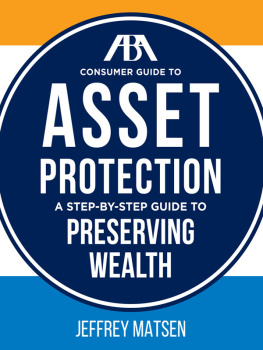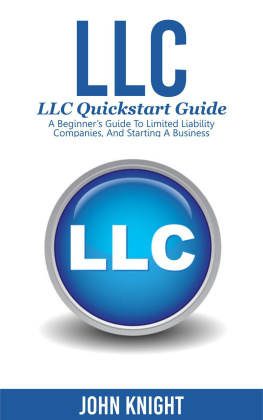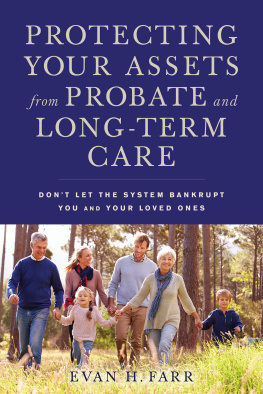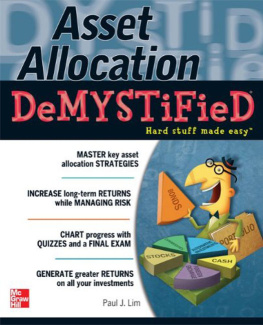
CONSUMER GUIDE TO
ASSET PROTECTION
A STEP-BY-STEP GUIDE TO
PRESERVING WEALTH
JEFFREY MATSEN
Contents
Preface
The one constant over the many years of my practice and among the hundreds of different clients I have served is the imbalance between, on the one hand, their profound concern regarding Asset Protection, and on the other, their lack of understanding of how to implement it.
The purpose of this book is to provide readers with a straightforward and elementary understanding of what Asset Protection really is and how it can be effectively implemented by taking various stepslike rungs on a ladder. By reading this book, you as readers are initiating the process of protecting the assets you have worked so hard to build and preserve. It is, in essence, the beginning of your journey in setting up this hypothetical ladder. The goal of this discussion is to give you enough basic information to take the all-important next step in implementing your Asset Protection plan, and help you truly climb the ladder of success.
Over the years, I have represented hundreds of small business owners, physicians, professionals, corporate executives, and real estate investors. My practice has centered on meeting my clients needs in the areas of Estate, Business, Asset Protection and Real Estate Planning. In addition, because of my substantial Estate Planning practice, I have also had extensive experience in Probate and Trust Administration.
Because most of these areas of the law are closely connected and become intertwined in the lives of my clients, it is important for them to have an integrated plan with respect to the protection, preservation, and transfer of their assets. That is why I have developed the concept of The Ladder of Successa multi-tiered approach to addressing our clients concerns and needs. Asset Protection Planning really is like a ladder: Such planning is multi-tiered and works together as a whole to bring an individual to a higher level of protection. Some of the steps of the ladder may not be relevant for each client, but for most professionals, almost all of the tiers are worthy of consideration and review.
The Ladder of Success is focused specifically on Asset Protection Planning and is designed to help all types of clients preserve and protect their assets during their lifetimes so they can be transferred in the most tax-saving and efficacious manner to the next generation.
Focus
Now, about the readers: I decided to write this book because of the tremendous need that business owners, physicians, other professionals, corporate executives, and real estate investors have with respect to protecting and preserving their assets. These individuals have worked hard and devoted tremendous time, effort, and capital in building up their estates. In the process, they have provided great services to our society. They have employed many people, they have paid taxes, and they have contributed significantly to the well-being of their clients and customers. They have made a difference and continue to do so with their creativity, energy, and business focus. These are people like you, who deserve respect, gratitude, and the happiness and peace of mind that come with knowing that their legacies are secure, that they can preserve and maintain their estates and pass them on to future generations.
In some small way, I hope this book can help them accomplish their goals and objectivesit is my way of thanking them for all they have given to society.
Asset Protection Planning
Business persons have always been concerned about the exposure of their personal assets to claims against their businesses. Certainly, protecting ones assets from the myriad risks involved in business and personal financial planning is not a novel objective or planning idea. The corporate form of business entity, with its shield of limited liability, has been invoked by professionals for centuries to protect those personal resources. Over the last few decades, expanding theories of liability and the proliferation of litigation have given increased emphasis to Asset Protection Planning to the extent that it is now a well-recognized area of practice. It certainly comes within the concept of lifetime Estate Planninginvolving the protection and conservation of accumulated wealth or asset base.
Shield of Liability
Business owners, physicians, and real estate investors must always be extremely concerned about potential liability against their personal assets, arising from the operation of the business or ownership of the real estate. Entities such as Corporations, Limited Liability Companies, and Limited Partnerships exist in part to prevent this potential personal liability.
- Corporations are formed to operate businesses and shield the corporate owner from personal liability against creditors of the business.
- Limited Liability Companies (LLCs) and Limited Partnerships (LPs) generally provide the necessary shield of liability for real estate investments; at the same time, they create favorable and flexible tax consequences because they are pass-through entities for income tax purposes.
- In addition, the potential limitation of the Charging Order remedy to creditors makes LLCs and LPs even more attractive and practical for business operators and real estate owners. (See for more details regarding the Charging Order remedy.)
NOTE
As our society has become more litigious, assent protection planning has become vitally important to business owners, real estate investors, physicians, and many other professionals.
For claritys sake, I will present an example of a typical business situation. Richard and his wife, Becky, own a small distribution business. They import products and distribute them on a wholesale basis to retail outlets. They have formed a corporation as the business entity for their distribution and operation. The office and warehouse that houses the distribution business is owned in an LLC, which they also own. The LLC then leases the premises to the distribution corporation. The corporation shield provides protection for Richard and Beckys non-business personal assets: creditors of the corporation can only seek redress from the corporation, and cannot normally attack the personal assets of the couple. The LLC provides protection to Richard and Beckys personal assets with respect to claims against the real estate itself. Richard and Becky were smart to segregate the real estate from the business operations and place the real estate in a separate liability-protected entity. In this way, a claim against the business will not necessarily impact the warehouse and offices inside the LLC. Moreover, a claim against the real estate will not necessarily impact the business operations inside the corporation and cannot normally be asserted against the other personal assets of Richard and Becky.
In June 2014, the US Supreme Court ruled in the case of Clark v. Ramker that an IRA (Individual Retirement Account) inherited from another is not a protected retirement fund and thus is subject to creditors claims in bankruptcy. What this means is that unless the beneficiary of an inherited IRA is the resident of a state that specifically exempts inherited IRAs from creditors, such as Alaska, Florida, Missouri, or Texas, the inherited IRA will not be protected from bankruptcy. It may also be that except in those few states, an inherited IRA will also be available to satisfy non-bankruptcy creditors. Accordingly, it is advisable that an individual name a Trust design specifically for the purpose of being the beneficiary of his/her IRA and other retirement plans. The individual can thus ensure that the inherited IRA is protected from creditors regardless of the residence of the beneficiary.








